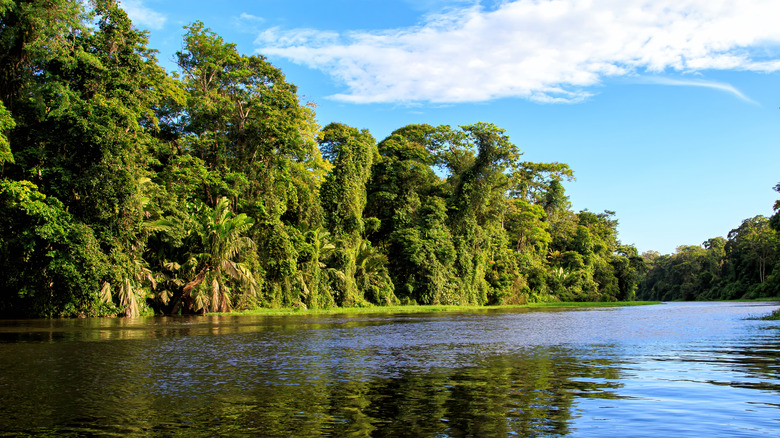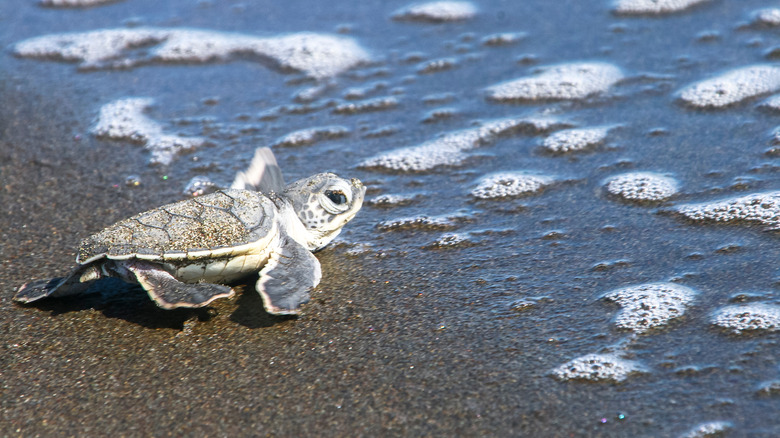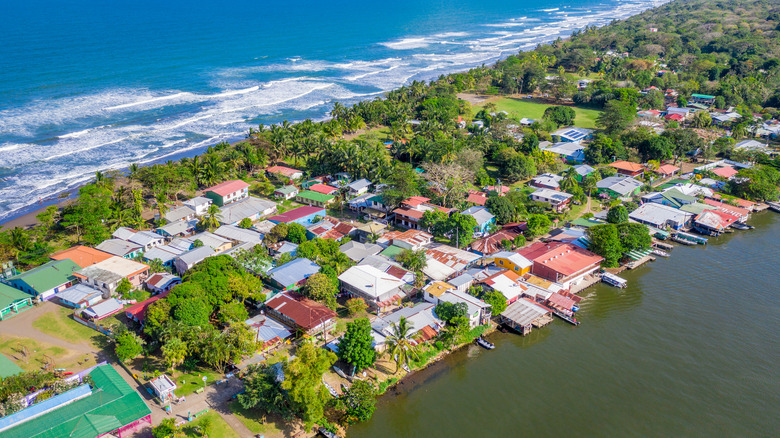This Underrated National Park In Costa Rica Is A Remote Paradise Famous For Its Wildlife
It's no secret that Costa Rica is a haven for nature and adventure lovers looking to chase thrills and explore unparalleled natural diversity. With 32 protected national parks, 51 wildlife refuges, 13 forest reserves, and eight biological reserves, it's clear that the Central American destination takes pride in its conservation efforts and rich ecosystems — all combined with the country's sustainability efforts. That said, it's no surprise that some of the country's national parks and reserves tend to fly under the radar as unheard-of treasures to travelers who haven't done their homework. One of these hidden gem destinations is Tortuguero National Park.
Away from the volcanic landscapes of Arenal Volcano National Park, the dry forests of Guanacaste National Park, and the popular beaches of Manuel Antonio National Park, Tortuguero National Park shines for its lush rainforests, winding waterways, and abundant wildlife. Located 50 miles north of Puerto Limón — the region's main port city — the park's 22-mile coastline along the Atlantic Ocean and roughly 47,000 acres are a great destination for birdwatching and turtle nesting observation.
Coming face-to-face with the local wildlife
One of the most important turtle nesting sites in Costa Rica — and the Western Hemisphere, actually — Tortuguero National Park welcomes the region's green sea turtles, leatherback sea turtles, hawksbill sea turtles, and loggerhead sea turtles as they look for the perfect place to lay their eggs. In fact, that's where the park's name comes from: Tortuguero roughly translates to "area filled with turtles."
Every year, between March and October, thousands of sea turtles flock to the national park to build their nests safely. To ensure the protection of these turtles and their nesting sites, the park offers guided tours for travelers who want to catch a glimpse of the process. Visitors aren't allowed to go near the nesting grounds unaccompanied at nighttime. As a recommendation, try and book a nighttime tour (and pack an all-black outfit!) during the start of the season if you want to catch a glimpse of the momma turtles as they nest. If you'd prefer to see the baby turtles hatching and making their way to the water, it's best if you book your visit between September and November.
In addition to sea turtles, the park is also home to more than 170 species of reptiles, 60 species of mammals, and more than 300 species of birds. From crocodiles to sloths, otters to parrots, and ocelots to manatees, Tortuguero National Park is a haven for wildlife enthusiasts.
Traveling to Tortuguero National Park
The best way to make your way to the park is to fly into San José Airport — in the capital city — and then take a connecting flight into Tortuguero — a small village inside the park — for about $130. Alternatively, if time isn't an issue and you'd rather save some cash, you can also hop aboard a public bus from San José to Cariari for about $3. In Cariari, look for shared taxis or public buses that will make the 1.5-hour drive to La Pavona for about $1.50. Finally, since there are no roads into or inside Tortuguero, you'll then need to take an hour-long boat ride into Tortuguero for an additional $3.
Once there, you'll find plenty of accommodation options that range from $12 to almost $300 a night, depending on the level of luxury you're after. Some of the most popular options include Laguna Lodge, Mawamba Lodge, Hotel Serendipity, Aracari Garden Hostel, and Miss Junie's Lodge. As for dining, top-rated spots like Restaurante Mi Niño, El Patio, Soda Doña Maria, Taylor's Place, and Miss Junies — just to name a few — will satisfy your cravings for everything from Caribbean bites to international cuisine.


